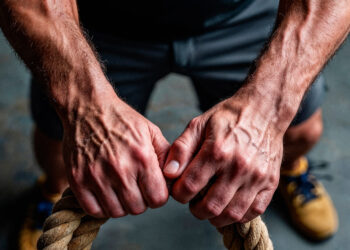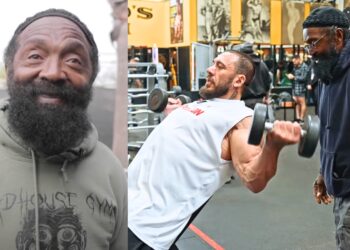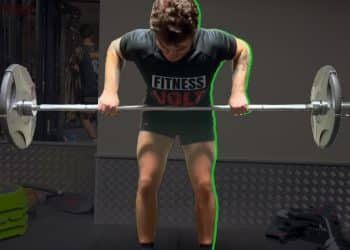The barbell bent-over row is a controversial exercise. In fact, some trainers label it as “contraindicated,” meaning most people should avoid it. This is mainly because bent-over rows involve unsupported forward flexion, which puts a lot of strain on your lumbar spine. Allow your lower back to round, and injuries are hard to avoid.
However, as a personal trainer with over 30 years of experience, I believe bent-over rows can be safe, provided they’re coached and programmed correctly. That’s not to say everyone is built to do them – they’re not. However, banning an exercise simply because it’s challenging to teach and learn seems shortsighted and even lazy.
So, what’s so great about bent-over rows? I’m glad you asked!
Simply put, they’re an effective pulling exercise that works your entire back, from the base of your spine to the nape of your neck (1). Your legs, glutes, shoulders, and arms also get in on the action. As such, bent-over rows are a very time-efficient, functional exercise. It’s no wonder that bodybuilders often say, “If you want to grow, you gotta row.”
But which grip should you use for bent-over rows – overhand or underhand? The answer depends on which muscles you want to prioritize.
In this article, we explore the differences between overhand and underhand barbell rows so you can pick the best one for your needs and goals.
Level Up Your Fitness: Join our 💪 strong community in Fitness Volt Newsletter. Get daily inspiration, expert-backed workouts, nutrition tips, the latest in strength sports, and the support you need to reach your goals. Subscribe for free!
Learn more about grip variations in bodybuilding here.
Overhand Bent-Over Rows
Overhand or pronated bent-over rows are typically done using a wider-than-shoulder-width grip. This naturally causes your elbows to flare away from your sides, so the bar travels toward your upper abdomen/lower chest.
This movement involves horizontal shoulder extension, meaning your arms are somewhat perpendicular to your body.
This joint action primarily involves the following muscles (2):
- Middle fibers of trapezius
- Rhomboids
- Posterior deltoids
In addition, like all rowing exercises, your biceps and forearms are also working.
While your latissimus dorsi muscles are involved in overhand grip bent over rows, it’s the traps, rhomboids, and rear delts that are doing most of the work. As such, overhand bent-over rows are best thought of as an upper back exercise.
Benefits of Overhand Bent-Over Rows
Are overhand bent-over rows the best choice for you? Consider these benefits and then decide!
Better posture – overhand bent-over rows target your main postural muscles, i.e., the core, erector spinae, mid-traps, rhomboids, and rear deltoids. Sitting and hunching can weaken these muscles, leading to a slouch. As such, overhand bent-over rows are an excellent antidote to prolonged sitting.
A thicker upper back – most exercisers focus on their lats during their back workouts. However, while developing the lats will widen your back, they don’t do as much for upper back thickness. Developing your mid-traps, rhomboids, and rear deltoids will give you a back that’s thick and wide, giving you a more balanced appearance.
A great forearm workout – while your upper back is the focus of overhand bent-over rows, you’ll also be training your forearms and grip. A pronated position means you’ll be doing a movement similar to reverse barbell curls, a well-known and proven forearm builder.
Of course, there are a couple of disadvantages to consider, too:
Lower back stress – pulling the barbell in toward your chest means the weight is significantly forward of your feet. This long lever puts more stress on your lower back. As such, you’ll have to work extra hard to stop your lower back rounding.
Reduced weight – the overhand grip puts your biceps in a mechanically disadvantageous position, so you won’t be able to lift such heavy weights. Consequently, while overhand bent-over rows are an excellent upper-back hypertrophy exercise, they’re less useful for building strength.
Wrist strain – while you should do your best to keep your wrists straight during overhand bent-over rows, this is not always possible. Subsequently, this exercise can put a lot of stress on your wrists and may be uncomfortable for some people.
Summary
Overhand bent-over rows are an effective upper back exercise. They primarily target the muscles between and across your shoulder blades. They’re good for building upper back thickness and improving posture. However, they’re not the best exercise for building low-rep strength.
Underhand Bent-Over Rows
Underhand or supinated bent-over rows typically use a shoulder-width or narrower grip. This hand position forces you to keep your elbows and upper arms close to your sides. Consequently, the bar naturally travels toward your abdomen.
This movement is shoulder extension, which targets the following muscles (2):
- Latissimus dorsi
- Middle fibers of trapezius
- Rhomboids
- Posterior deltoids
Needless to say, your biceps are also involved in this exercise.
While underhand bent-over rows work all your major back muscles, it’s your latissimus dorsi that are the agonists or prime movers. As such, this rowing variation is best thought of as a lat exercise, although your upper back muscles are also involved, albeit to a slightly lesser degree.
Benefits of Underhand Bent-Over Rows
Are underhand bent-over rows the best exercise for your back workouts? Consider these benefits and then make your choice:
Build a wider back – well-developed lats are visible from the back and the front. They give your upper body its width and look like muscular wings. If you want an impressive V-taper, underhand barbell rows will help.
Lift more weight – the underhand grip puts your biceps in a biomechanically favorable position and allows you to use the full power of your lats. This means you should be able to lift more weight and create more muscle tension. Muscle tension is one of the main triggers of hypertrophy (3).
Develop bigger biceps – underhand rows involve a similar arm movement to barbell curls. Consequently, they provide a very effective workout for your biceps. So, no time to train your back and biceps? No problem, because underhand rows do it all.
Less lower back stress – pulling the bar into your abdomen means the weight is closer to your feet than overhand rows, where the bar travels to your chest. This creates a shorter lever and puts less stress on your lower back.
Level Up Your Fitness: Join our 💪 strong community in Fitness Volt Newsletter. Get daily inspiration, expert-backed workouts, nutrition tips, the latest in strength sports, and the support you need to reach your goals. Subscribe for free!
As always, there are also a couple of disadvantages to consider, too:
Increased risk of cheating – underhand bent-over rows lend themselves to heavier weights. The position of your hands and elbows means you could use 10-20% more weight than with overhand rows. While this is a benefit for building strength, it could also overload your supporting musculature, leading to form breakdown or cheating.
Elbow strain – some people find fully extending their arms with a supinated grip puts a lot of stress on their elbows and biceps tendons. While this is not always the case, elbow strain is not uncommon during underhand barbell rows.
Summary
Underhand bent-over rows are an excellent lat exercise. Well-developed lats will give your upper body more width. In addition, the supinated hand position means you’ll be able to lift more weight, making this a good variation for building both muscle size and strength. On the downside, this exercise can sometimes cause elbow pain.
Overhand or Underhand: Which Grip Should You Use?
While it’s perfectly acceptable to do both overhand and underhand rows, maybe alternating workout by workout, there may be times when one is better than the other. It all depends on your needs and goals.
Here’s a handy chart that’ll make it easier to choose between overhand and underhand rows:
| Aspect | Overhand Bent-Over Rows | Underhand Bent-Over Rows |
| Hand position | Wider-than-shoulder-width | Shoulder-width or narrower |
| Bar Path | Toward upper abdomen/lower chest | Toward abdomen |
| Primary Muscles | Middle trapezius
Rhomboids Posterior deltoids |
Latissimus dorsi
Middle trapezius Rhomboids Posterior deltoids |
| Secondary Muscles | Biceps, forearms | Biceps, forearms |
| Additional Benefits | Better posture
Thicker upper back Secondary forearm workout |
Increased back width
Lift more weight Less lower back stress Secondary biceps workout |
| Disadvantages | Increased lower back stress
Wrist strain Less suitable for heavy loads |
Elbow strain
Increased risk of cheating |
FAQ’s
Do you have a question about overhand vs. underhand barbell rows? No problem—I’ve got the answers! If you need more information, please leave a comment below, and I’ll reply ASAP.
1. Are bent-over rows safe?
Bent-over rows can be safe, provided you do them correctly. That means bracing your core, keeping your lower back slightly arched and not rounded, maintaining a slight bend on your knees, and not using too much weight.
Follow these guidelines, and bent-over rows should be no more hazardous than any other horizontal pulling exercise.
2. I can only do one barbell rowing exercise; which should I choose?
The underhand grip barbell row offers more bang for your buck, so that would be my choice if I could only do one rowing exercise. After all, it works your lats, upper back, and biceps. Overhand rows are great for mid-traps, rhomboids, and rear delts but won’t do much for your biceps and lats.
3. Can I vary my grip during other rowing exercises to change their effect?
You certainly can! You can use an underhand or overhand grip with most rowing exercises to change how they affect your muscles. This includes:
4. How does a neutral grip affect muscle engagement during rows?
A neutral or parallel grip tends to force your upper arms in toward your body, which emphasizes shoulder joint extension to target the lats. As such, it’s a lot like using an underhand grip.
However, you’ll also lose a little of the biceps mechanical advantage you get from a fully supinated grip, although some people find a neutral grip much more comfortable.
5. How many reps and sets of bent-over rows should I do?
Your rep range should reflect your training goal. Building strength is best done with low reps and heavy weights, with 1-5 being typical. In contrast, the best way to build muscle size is with moderate to light weights and medium to high reps, e.g., 6-35 (4). Provided you train close to failure, almost any rep range will build muscle.
That said, bent-over rows are not ideal for very heavy low-rep training. The risk of injury is too high. Instead, bent-over rows are best kept for hypertrophy workouts.
Regarding sets, 2-4 should be enough for most people. If you feel like you need more, you are probably stopping your sets too far from failure or resting too long between efforts.
Closing Thoughts
Contrary to what many trainers believe, the bent-over row is not inherently dangerous. Done correctly, it can be a safe and effective exercise. However, if you ignore the need for good form or program it incorrectly, this movement will soon show you its teeth!
Regarding the underhand vs. overhand debate, the answer depends on which muscles you want to emphasize. Use an underhand grip to target your lats and an overhand grip for your upper back. Choose the best option for your needs and goals.
Whichever one you choose, you’ll get a great low-tech but high-effect back workout.
References:
- Fenwick CM, Brown SH, McGill SM. Comparison of different rowing exercises: trunk muscle activation and lumbar spine motion, load, and stiffness. J Strength Cond Res. 2009 Mar;23(2):350-8. doi: 10.1519/JSC.0b013e3181942019. PMID: 19197209.
- Lehman GJ, Buchan DD, Lundy A, Myers N, Nalborczyk A. Variations in muscle activation levels during traditional latissimus dorsi weight training exercises: An experimental study. Dyn Med. 2004 Jun 30;3(1):4. doi: 10.1186/1476-5918-3-4. PMID: 15228624; PMCID: PMC449729.
- Schiaffino S, Reggiani C, Akimoto T, Blaauw B. Molecular Mechanisms of Skeletal Muscle Hypertrophy. J Neuromuscul Dis. 2021;8(2):169-183. doi: 10.3233/JND-200568. PMID: 33216041; PMCID: PMC8075408.
- Lasevicius T, Ugrinowitsch C, Schoenfeld BJ, Roschel H, Tavares LD, De Souza EO, Laurentino G, Tricoli V. Effects of different intensities of resistance training with equated volume load on muscle strength and hypertrophy. Eur J Sport Sci. 2018 Jul;18(6):772-780. doi: 10.1080/17461391.2018.1450898. Epub 2018 Mar 22. PMID: 29564973.








